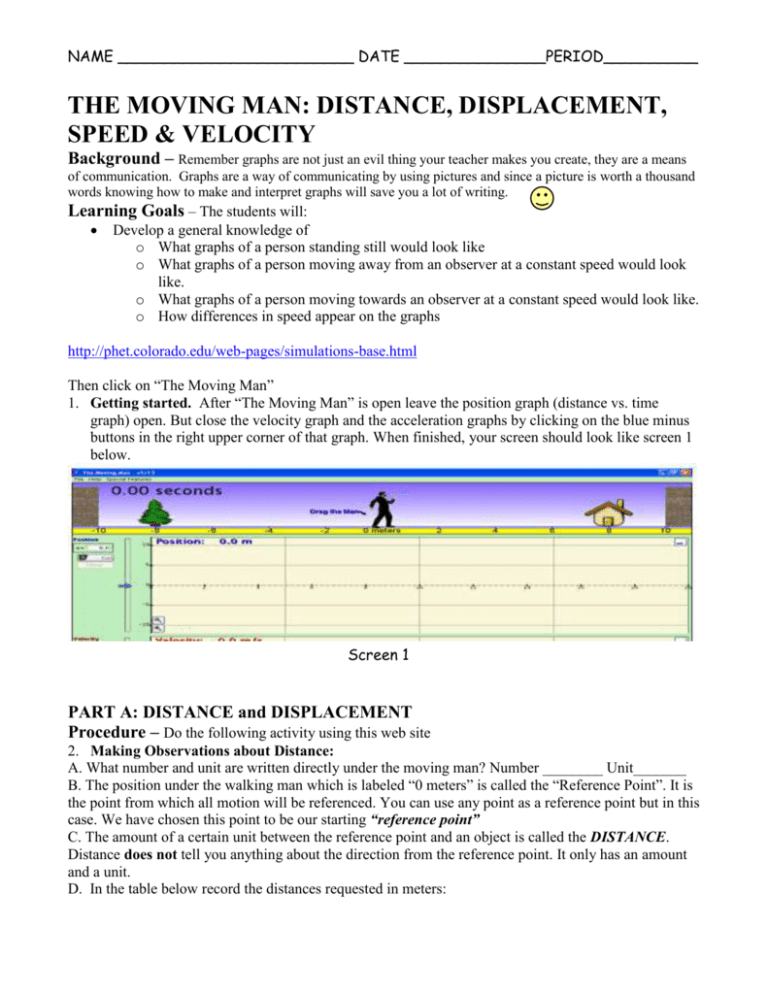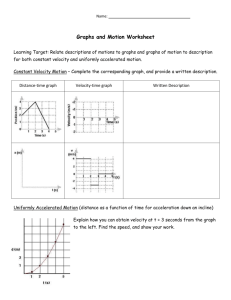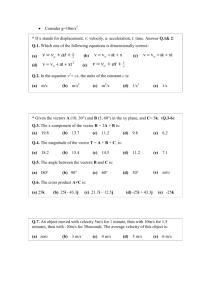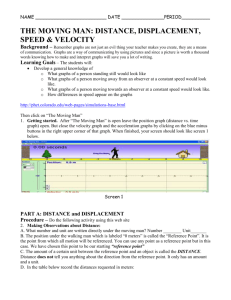Moving Man: Distance, Speed & Velocity Worksheet
advertisement

NAME _________________________ DATE _______________PERIOD__________ THE MOVING MAN: DISTANCE, DISPLACEMENT, SPEED & VELOCITY Background – Remember graphs are not just an evil thing your teacher makes you create, they are a means of communication. Graphs are a way of communicating by using pictures and since a picture is worth a thousand words knowing how to make and interpret graphs will save you a lot of writing. Learning Goals – The students will: Develop a general knowledge of o What graphs of a person standing still would look like o What graphs of a person moving away from an observer at a constant speed would look like. o What graphs of a person moving towards an observer at a constant speed would look like. o How differences in speed appear on the graphs http://phet.colorado.edu/web-pages/simulations-base.html Then click on “The Moving Man” 1. Getting started. After “The Moving Man” is open leave the position graph (distance vs. time graph) open. But close the velocity graph and the acceleration graphs by clicking on the blue minus buttons in the right upper corner of that graph. When finished, your screen should look like screen 1 below. Screen 1 PART A: DISTANCE and DISPLACEMENT Procedure – Do the following activity using this web site 2. Making Observations about Distance: A. What number and unit are written directly under the moving man? Number ________ Unit_______ B. The position under the walking man which is labeled “0 meters” is called the “Reference Point”. It is the point from which all motion will be referenced. You can use any point as a reference point but in this case. We have chosen this point to be our starting “reference point” C. The amount of a certain unit between the reference point and an object is called the DISTANCE. Distance does not tell you anything about the direction from the reference point. It only has an amount and a unit. D. In the table below record the distances requested in meters: NAME _________________________ DATE _______________PERIOD__________ DISTANCE FROM Walking Man (reference point) to…. The House The Wall The tree 3. Making Observations about Displacement: A. You may have noticed that the distance to the tree has been given a negative value while the distance to the house has been given a positive value. Stop and think for a moment. Why do you suppose this has been done? B. When we add a “-“ or a “+” to the number we are indicating a direction. A “-“ sign means “backward or behind” and a “+” sign means “forward or in front”. They indicate the direction of an object from the chosen reference point. Adding the “+” or “-“ sign indicates DISPLACEMENT (not distance). Displacement, like distance has an amount (magnitude) and a unit, but displacement also has a direction. Distance does NOT have a direction. When we want to indicate direction in more than two directions (e.g. forward and backward), we use words like north, south, east, west, northwest etc. We can also use degrees of a circle with the reference point being the center of a circle. D. In the table below record the distplacements requested in meters. Use “-“ and “+” to indicate direction from the reference point (Be sure to also include an amount and a unit.) DISPLACEMENT FROM Walking Man (reference point) to…. The House The Wall The tree What is the difference between an object’s DISTANCE and its DISPLACEMENT? _______________________________________________________________________ PART B: SPEED AND VELOCITY Introduction: When an object changes position over a period of time we say that it is in MOTION. When an object changes position (moves), there are several things we can measure about the motion: A. We can measure how much DISTANCE the object traveled as it changed position. (the length of its path) B. We can measure how much TIME it took for it to change position. C. We can describe the DIRECTION it went as it changed position. NAME _________________________ DATE _______________PERIOD__________ D. We can measure its SPEED as it changed position. Speed compares the DISTANCE it traveled to the TIME it took to travel that distance. If an object covers a lot of distance in very little time, we say its speed is fast. If it covers very little distance in an amount of time, we say that its speed is slow. E. We can describe its VELOCITY as it changes position. Velocity compares the amount that the objects DISPLACEMENT (direction and distance) have both changed during a certain amount of TIME. If the object has covered a lot of distance OR changed its direction a lot, then we say it has a fast velocity. What is the difference between an object’s SPEED and its VELOCITY? _______________________________________________________________________ Procedure – Do the following activity using this web site 1. Making observations. A) The unit of distance in the moving man is ____________(yellow bar) B) The unit of time used in the moving man is ___________ (blue sky) C) Set the moving man’s velocity (≈ speed) at 1meters/sec and hit go. Watch the moving man. D) Set the moving man’s velocity (≈ speed) at 4 meters/sec and hit go. Watch the moving man. E) At which of the two velocities did he move faster? __________(Watch them both again if you need to.) F) Set the moving man’s velocity (≈ speed) at 1meters/sec. Before hitting go, locate the clock again. You are going to let the moving man go for 2 seconds and then hit pause. Now hit go. If he goes more than 2 seconds, simply grab the blue bar and back it up until the clock says 2 seconds. Record the distance covered in the table below. G) Repeat Step (F) above but set the velocity (≈ speed) at 4 meters/sec. Again let him go for 2 seconds only. TRIAL #1 SPEED 1 meter/sec (slower) TIME 2 seconds DISTANCE COVERED TRIAL #2 4 meter/sec (faster) 2 seconds 1. In both of the above trials you gave the man 2 seconds to run. At what velocity did he cover more distance? 2. Speed is calculated by comparing (dividing) the distance with the time. Divide the distance by the time for each trial above. Write the speeds below TRIAL #1 _________ meters divided by __________sec = _____________ m/sec NAME _________________________ DATE _______________PERIOD__________ TRIAL#2 _________ meters divided by _________sec = ______________m/sec PART C: GRAPHING SPEED 1.Making observations. A) Explore: By either clicking on the man or the slider, cause the man to move back and forth and observe what shows up on the graphs. B) Record: Using the axis provided below make sketches of “Distance vs. Time” and “Velocity vs. Time” graphs for the actions described on the left side of each axis. from 0m to 10m at a steady fast pace then moving back to 0 m at a steady slow Time (s) 10 5 0 -5 -10 Time (s) 10 5 0 -5 -10 Time (s) 10 Distance (m) SKETCH 4: A man moving -5 -10 Distance (m) SKETCH 3: A man standing still at 4m 5 0 Distance (m) SKETCH 2: A man moving from 0m to 10m at a fast pace. Distance (m) SKETCH 1: A man moving from 0m to 10m at a slow steady pace. 10 Time (s) pace. from 0 to 10 meters at an ever-increasing speed (acceleration) Distance (m) Sketch 5: A man moving -5 -10 Time (s) NAME _________________________ DATE _______________PERIOD__________ Apply what you learned. Look at the graphs above and answer the following questions. 1) EXPLAIN the difference in motion represented by a straight line and a curving line on a “distance vs. time” in terms of constant or changing speed. ___________________________________________________________________________ 2) Changing speed is called “acceleration” (speeding up) or deceleration (slowing down). Describe the shape of an acceleration line on a Distance vs. Time graph of acceleration. ___________________________________________________________________________ 3) EXPLAIN the difference between the motion represented by a flat line and a sloping straight line in a “distance vs. time” graph. ___________________________________________________________________________ 4) If the slope of a line on a “distance vs. time” graph is steep. What is different about the motion then when it is not steep? 5) Look at the graph below and answer the following questions. A) CALCULATE the average speed/velocity between point B & Point C by finding the slope of the line between the 6th and 15th seconds (show work below) B) Why is the line sloping upward to the right between the 2nd & 3rd second, but downward to the right between 6th and the 15th seconds? _________________________________________________________________________ C) During what two times did he stop moving? Time 1 _________________________________ Time ___________________________________ Distance Time -10 10 -5 5 0 NAME _________________________ DATE _______________PERIOD__________






